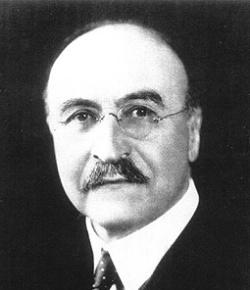Where it all started: Mr "Bakelite"

Leo Henricus Arthur Baekeland FRSE(Hon) November 14, 1863 – February 23, 1944
Introduction
(Based on extracts from Wikipedia)
One of the first plastics made from synthetic components, Bakelite was used for its electrical Non-conductivity and heat-resistant properties in electrical insulators, radio and telephone casings, and such diverse products as kitchenware, jewellery, pipe stems, firearms children's toys and of course door furniture. The "retro" appeal of old Bakelite products has made them collectible.
History
Baekland was already wealthy, due to his invention of Velux photographic paper, when he began to investigate the reactions of phenol and formaldehyde in his home laboratory. Chemists had begun to recognise that many natural resins and fibres were polymers. Baekland's initial intent was to find a replacement for shellac, a material that was in limited supply because it was made naturally from the excretion of lac bugs. Baekeland produced a soluble phenol-formaldehyde shellac called "Novolak, but it was not a market success.
Synthesis
Bakelite is a combination of phenol and formaldehyde, with wood flour as a filler. The mixture is put under pressure and after curing, a hard plastic material forms.
Making Bakelite was a multi-stage process. It began with the heating of phenol and formaldehyde in the presence of a catalyst such as hydrochloric acid, zinc chloride, or the base ammonia. This created a "liquid condensation product", referred to as "Bakelite A", which was soluble in alcohol, acetone, or added phenol. Heated further, the product became partially soluble and could still be softened by heat. Even more heating resulted in an "insoluble hard gum". However, the high temperatures required to create this tended to cause violent foaming of the mixture, which resulted in the cooled material being porous and breakable. Baekeland's innovative step was to put his "last condensation product" into an egg-shaped "Bakelizer". By heating it under pressure, at about 150 °C., Baekeland was able to suppress the foaming that would otherwise occur. The resulting substance was extremely hard and both infusible and insoluble.
Compression Moulding
Powdered "Bakelite A" could be combined with wood flour and moulded in hydraulic presses to create solid objects. Bakelite acted as a binder, surrounding the filler, and solidifying with a smooth finish. Bakelite's moulding process had a number of advantages. Bakelite resin could be provided either as powder, or as preformed partially cured slugs, increasing the speed of the casting. Thermosetting resins such as Bakelite required heat and pressure during the moulding cycle, but could be removed from the moulding process without being cooled, again making the moulding process faster. Also, because of the smooth polished surface that resulted, Bakelite objects required less finishing. One of the first Bakelite moulded products, produced by the Boonton Rubber Company, was a tiny bushing, the size of a mustard seed, created for Weston Electric in 1908. Millions of parts could be duplicated quickly and relatively cheaply.
Bakelite is a registered trademark of Hexion Specialty Chemicals AG



